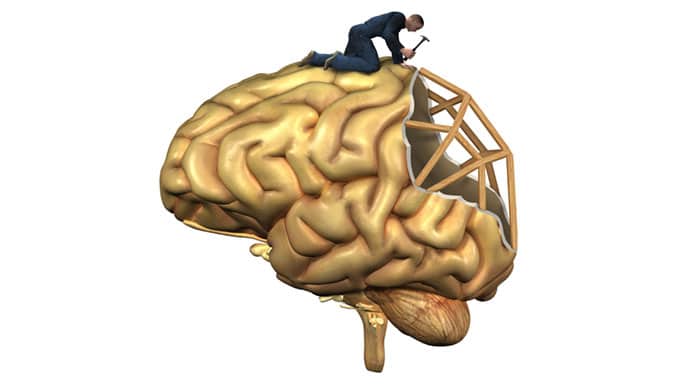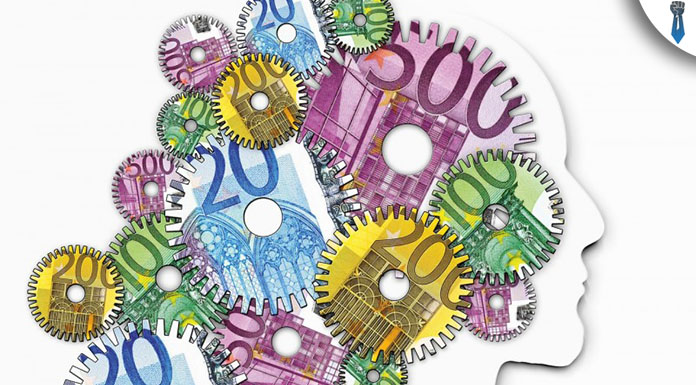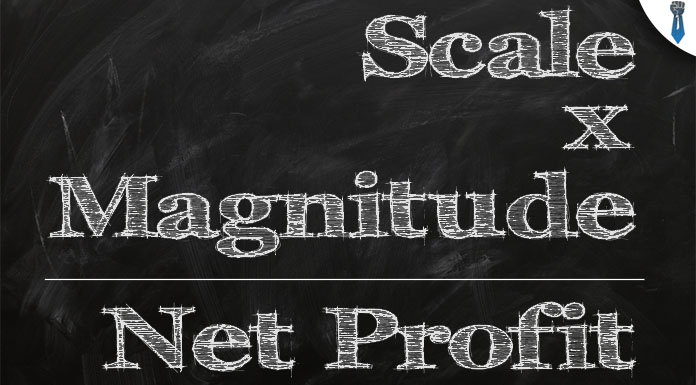“Come on mom,” I’m gonna show you how this new app works. It’s a piece of cake”, I said.
“Nah, leave me alone, I’m too old for this technology shit. You can’t teach an old dog new tricks”, she told me.
“Too old huh? Then, how do you explain this?” Showing her new record on Candy Crush on Facebook.
“Well, it’s just a silly game I like to play in my leisure time.” She mumbled.
“I see…so I guess old dogs can learn a few new tricks when they want to huh?” I winked at her.
Now. Let’s leave all these lame excuses behind and I’ll show you how you can teach an old dog (or a brain of any age some new tricks).
I’d like you to pay much attention to today’s article because knowledge, habits, and skills are the most important deciding factors when it comes to someone’s success or failure in life.
“We are what we repeatedly do. Excellence, then, is not an act but a habit.”
~Aristotle
Think of this article as a guideline for every new habit you’ll want to implement in your life from now on. I will not only prove to you that changing the hardware of your brain is possible, but I’ll also show you how to do it step-by-step.
*Disclaimer: I am not a neurosurgeon or even a medical student, but all the things mentioned in this article are *common* knowledge nowadays. Information is widely available over the Internet in a thousand different places. Moreover, I will provide the resources needed cause I don’t want you to think that I pulled all these out of my a$$.
A bit of neuroscience
For many years, scientists believed that the brain’s structure was fixed. They thought of it incapable of physical change. More like a machine. Machines can perform a lot of functions, but their internal structuring, cabling, parts, etc. always remain the same.
Modern research has proven that our brains are not only capable of altering the internal structure “cabling,” but they can do so, at any age.
So the next time a middle-aged lady or an old man, gives you the same rhyme about the old dog, just remember. Science has proven otherwise.
What’s really a habit?
In order to show you what a habit is and how to acquire a new one, we’ll need to take a look inside our head. So let’s zoom in a bit inside our most valuable organ. The human brain.
The brain Central Nervous System (CNS) is mainly divided into three cell types, Neurons, Glial Cell Types (Astrocytes and Oligodendrocytes), and Microglia. All of them, have a different job to do, but the one we are going to take a closer look now are the Neurons.
It’s estimated that the human brain carries around 1014 (100 billion neurons). In comparison, the common fruit fly has around 100.000 neurons.
What do I care about neurons man? I just want to learn how to play the guitar and quit smoking. I don’t give a #$%& about common fruit flies!
Hang on a little bit more please. We’re getting there. This is among the most important chapters in whole neuroscience. So I think we can devote a couple more paragraphs to it.
The primary job of the neurons is to transmit signals between them, through very complex electrical and chemical reactions.
A typical neuron possesses a soma (the bulbous cell body which contains the cell nucleus), dendrites (long, feathery filaments attached to the cell body in a complex branching “dendritic tree”) and a single axon (a special, extra-long, branched cellular filament, which may be thousands of times the length of the soma).
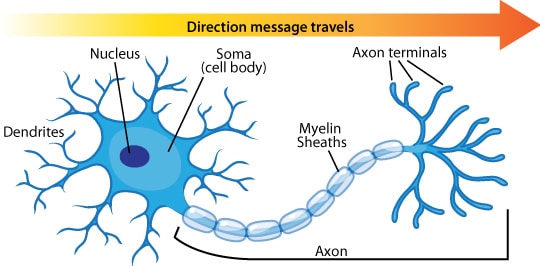
Image Credits: Ask a Biologist
Synapses are called the points where neurons are connected. Whenever a neuron needs to transmit a piece of information to the next one, it uses this synaptic connection to do so.
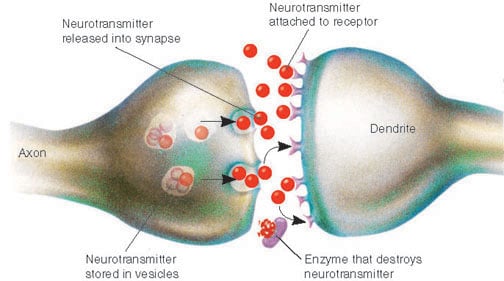
Image Credits: Cargocollective
Neurogenesis
Neurogenesis is called the process during which, our brains, produce new neurons. Although it was believed that neurons stop to reproduce after the first years of life, in 1999, researchers at Salk Institute, San Diego discovered that neurogenesis can occur throughout our entire lives. They noticed neurogenesis occurring in the brain of a 72-year-old adult.
But why is neurogenesis so important?
Because it’s the way our brain rewires itself. By constantly creating or killing neurons, our brain has the great capability to restructure its internal wiring. In plain English, that means that if our computer motherboard could operate like our brain, it could change the copper paths from the processor to the memory, and from there to all the inputs and outputs at will.
It would be like a liquid or plastic piece of machinery.
Extraordinary huh?
The human brain also has “copper paths” which are called pathways. Neural pathways are capable of connecting relatively distant areas of the brain or nervous system. Each pathway is associated with a particular action or behavior.
Please pay attention to this last line.
Each pathway is associated with a particular action or behavior.
There are hundreds of such pathways in our brain. Every time a new action, behavior or desire takes place, our brain can utilize one or more of these pathways at will.
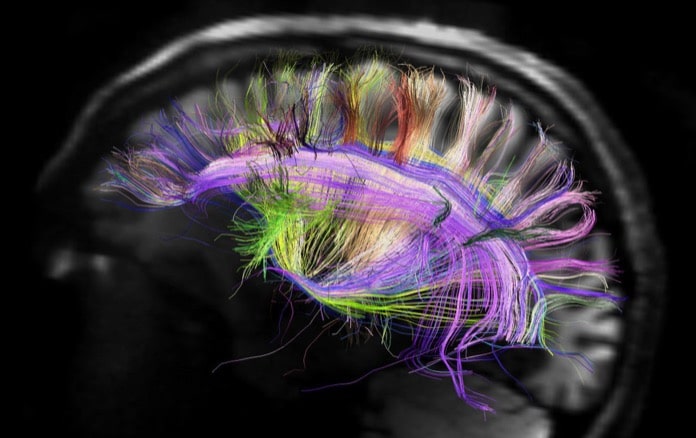
Image Credits: SQonline
This is where the magic happens actually.
All pathways start thin and weak in the beginning, but as time passes and we practice the same action again and again, this pathway (or set of pathways) gets thicker and stronger.
Thicker means faster and more accurate access.
The 4 steps of knowledge
In order to learn something new like a skill, memory, etc. every human being has to pass through the 4 steps of knowledge. Some skills are easy, and these 4 steps can be passed fast, but some other are more complex and will require more effort than others.
So, let’s say that you want to learn a new skill, like driving a car. The four stages would be:
1. Unconscious incompetence
This is the stage where you are unaware of the skill or knowledge both in the subconscious and conscious level. You didn’t care about driving a car when you were 8 years old, right? Or maybe you don’t care how to become a millionaire building an online business as we speak.
2. Conscious incompetence
This is the stage where you decide that you want to learn a new skill, habit or knowledge and you start practicing it. It’s when you get in the car for the first couple of times. All these levers, pedals, and the steering wheel don’t mean much to you. You know that you want to use them, but you still don’t know how.
3. Conscious competence
This is where things start to catch up. This is the stage where you know how to perform the new skill or habit, but you need to put conscious effort into doing it. It’s when you took the car for driving in the beginning. You were always thinking what to do. Like I need to turn the wheel, or I need to brake, or now I need to shift gear, etc.
I’m in a similar situation at this moment, because I’ve decided to acquire a new habit myself. I wanted to squat each time I needed to pick something off the floor instead of stooping.
But because we’re all accustomed to change from squatting to stooping as we’re getting older (not sure why this happens), I’ve decided to make it the baby style. (I find it healthier in the long run).
So now, each time I want to pick up something, I consciously think I need to squat and not to stoop.
4. Unconscious competence
There you are. You finally got it right. This is where the new habit or knowledge has passed into the sub-conscious part of the brain, and it’s performed on autopilot. After a few thousands of miles behind the wheel, you’re capable of driving without thinking about it. You can even talk to your cellphone or eat and drive at the same time (although it’s not advisable to do so).
I know after some more practicing, I will squat on autopilot instead of stooping. (I will update you how long this will take me).
So what has happened in the physical structure of our brain during these 4 stages?
In simple words, the pathways associated with the driving skill went from thin lines (short of speak) to thick ropes.
By accessing the same areas of your brain, again and again, all the time, the pathways associated with this action, got thicker and stronger. Your brain understands that these pathways are important for you to grow because of continuously accessing them. The throughput in these pathways went way up and consequently you can now drive your car very easily by consuming a little amount of brain power.
As a final visual image think of the following example. Imagine each new pathway like a small rope bridge. Every time you access this pathway(s) it’s like upgrading your bridge with a new feature. One time you put new cables, the next time you make it a bit larger, the third time you make it wider, the fourth time you put steel cables and tarmac, and so forth.
But actually the opposite is quite true as well. The less we use a set of pathways the weaker it gets. The most common example are our very memories. Memories are also pathways, so if an event has taken place a few years back and you haven’t accessed this memory pathway, your brain understands that this isn’t so important and it weakens the pathway. This way it can redirect resources, energy, speed, etc. to other pathways more crucial to your survival.
Learning a new skill or habit (the efficient way)
Tons of ink have spent into explaining how to acquire a new skill or habit. I will try to explain it to you in a few paragraphs. Now that you have all the background knowledge it should be relatively easy.
So, to learn a new skill or habit, you only need these 3 simple steps.
Step #1: Should be important to you
First things first. No matter how many tricks, tactics, guides and scientific journals you’re gonna read, if the new skill, habit or knowledge isn’t important to you, the whole process is doomed.
Before you start you’ll need to find out what really drives you. What motivates you to do each and every day passionately. Unfortunately I don’t have a solution for lazy people. The train to excellence doesn’t make a stop at Lazyland.
[bctt tweet=”The train to excellence doesn’t make a stop at Lazyland.” username=”projectbebest”]
If you don’t feel motivated enough about doing something, then stop doing that, and try something else. Think about what gets you fired up and go down that path. Internal motivation is the most powerful one and the one that’ll keep your candle burning through rough times.
Listen, when I talk about acquiring a new skill or habit, I’m not talking only about becoming a millionaire. These can also be small, everyday habits, like the one I mentioned before with squatting.
Remember. The easier the skill, the easier you’ll pass through the 4 steps.
If you’ve already locked your target, fantastic, you may proceed.
Step #2: Lower the activation energy cost
As very nicely Shawn Achor says in his book “The Happiness Advantage,” sheer willpower isn’t enough to make it happen.
What that means is that if the new skill or knowledge is hard, only pushing through might not be enough.
So before starting with it, you’ll need to fix your environment in such a way that it’ll keep your activation cost low.
Let’s see a practical example. Let’s say that you want to lose some weight. The first step is always to fix your diet. But simply having a good diet plan isn’t enough.
You’ll also need to alter your environment in such a way to make it easier for you to stick to it. This means you’ll have to throw all the junk food away from your home, and fill your fridge with fresh fruits, vegetables and lean protein sources like eggs, chicken and fish.
That way you’ll make massive willpower conservation every time you’ll think to eat something. If you’re hungry the easiest solution at the moment, will be to eat a carrot, an apple, or some eggs. But guess what your choice would be if you had a house full of biscuits, cakes, and carbonara.
Step #3: Use your willpower to pass through the pain period
If you have made it up to here, that means you’re serious about it. The new habit is kinda important to you, and now you’re on the last step to make it yours. But don’t fool yourselves, because it’s also the hardest one.
This is the step where most people fail and you’ll see why.
Now it’s time to use your sheer raw willpower. Like a space rocket when leaving the earth’s atmosphere it uses almost 80% of its fuel, the same way you’ll need to use most of your willpower to install the new habit into your subconscious.
The thinner the pathways, the more energy you’ll need to consume to perform the action/habit and the harder it’ll be to stay aligned with your goal.
According to Gary Keller, in “The ONE Thing,” studies have show that on average we need about 66 days to acquire a new powerful habit. For some, it might be less and for some a bit more. Don’t get caught up with the numbers here. The important thing is that you’ll have to withstand the initial pain period until your pathways become like thick ropes.
If the new habit, skill or knowledge is important enough to you, and you have set up an efficient environment then by applying your willpower should be sufficient to get the job done.
Also to take notice. Try to acquire one powerful habit at a time. Great people know how to use this to their advantage. Things don’t have to be done in parallel. Don’t try to quit smoking and lose weight at the same time. Both will need big amounts of willpower, and you’ll do your life harder. One step at a time. Just make a plan and have a list of all the new habits you want to acquire together with a designated date.
Conclusion
Not only we have learned how the brain works and why we learn stuff, but we’ve also learned the exact method we need to follow to learn a new skill or knowledge.
So to recap:
Our brain is an engineering marvel of about 1300gr. Although it’s only about 1/50th of our size, it consumes about 1/5 of the total body energy (calories).
All our thoughts, feelings, emotions, needs, skills, memories, etc. are stored in there. Each one of them is a set of lines transferring electrical and chemical signal between remote areas of the brain called pathways.
So in order to make any change to our emotions, skills or memories we need to alter the physical structure of our brain. We need to take each set of pathways and make it bigger.
The process below will help you to enlarge these pathways like a charm.
Step# 1: Make it significant. In order to learn a new hard skill or acquire a new habit (lose weight, quit smoking, learn a new language, become a guitar player), it will have to be important to you. From my knowledge I’ve seen that if there’s not a strong internal motivation, all the external influence in the world is not gonna do it. Try to become internally motivated for that thing because otherwise, you’re fighting an uphill battle.
Step #2: Fix your environment. Make your environment as efficient as possible. We humans in order to do things, we need to consume some mental energy. Fixing our environment by removing harmful elements or by adding positive enforcers will lower the willpower consumption and make the whole process a lot easier.
Step #3: Use your willpower. Depending on the size of the pathways this willpower consumption can be little (for an already acquired skill or knowledge), to a lot (if we’re in the process of getting a new one). The hardest part is always in the beginning when the pathways in our brain are small and to activate them we need to consume more of our willpower. If you manage to control your emotions and persevere during this difficult period, then the whole thing will start to work in your favor. With more practice, the pathways will grow bigger and eventually will require low to no energy to function. Remember the car driving example.
From my experience up to now, I’ve seen that each time I wanted to acquire a new skill (I’m learning Italian at the moment, and I’m 36 years old) I had to make sure, that all these factors were in place. It made my life a lot easier, more fulfilling and it made me feel so goooood in the end!
If you think you got some valuable knowledge from this article, please share it with your friends and comment below for any useful insights.
